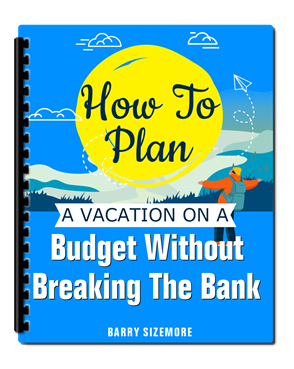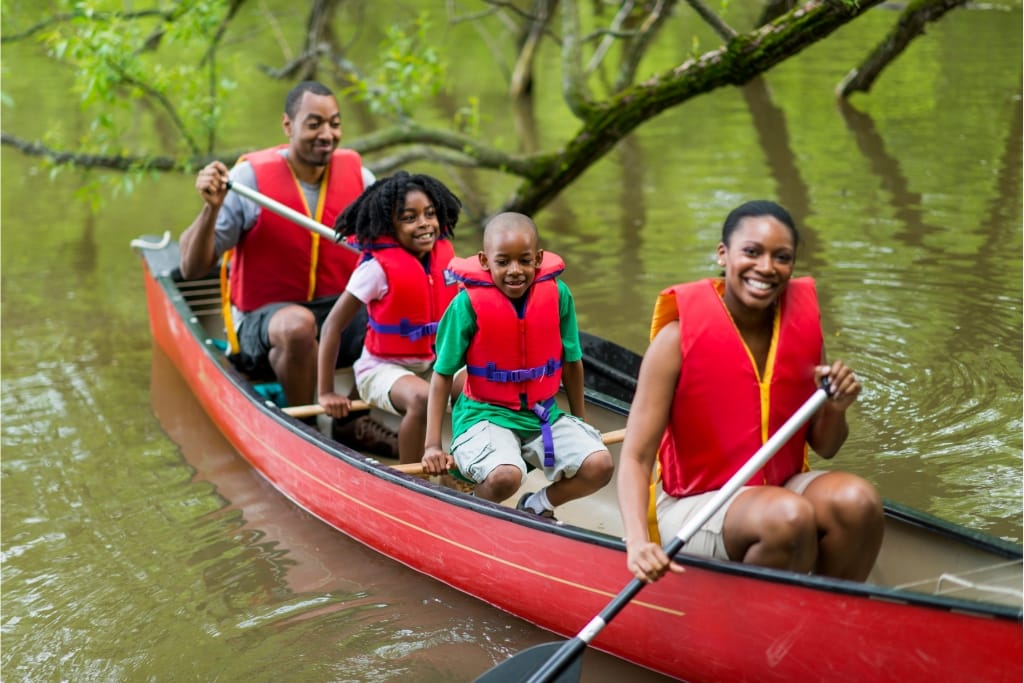Canoeing is a fantastic way to experience the great outdoors, offering adventure, relaxation, and fitness opportunities.
Starting on the right foot with proper techniques and preparation can make your time on the water safer and more enjoyable.
Whether you're new to paddling or looking to sharpen your skills, these tips will help you gain confidence and fully appreciate the joys of canoeing.
1)) Take Lessons
Taking lessons from a qualified instructor is one of the best ways to start your canoeing journey.
An experienced teacher can demonstrate proper paddling techniques, explain safety procedures, and provide valuable insights into handling various water conditions.
Lessons are also an excellent opportunity to familiarize yourself with canoeing equipment and practice under guided supervision.
Learning the basics from a professional sets the foundation for safe and enjoyable adventures, giving you the confidence to explore waterways with ease.
2)) Wear A Life Jacket
Wearing a life jacket is essential for every canoeing trip, regardless of your swimming ability or experience level.
A properly fitted life jacket provides crucial buoyancy and can save your life in case of an accidental capsize or fall into the water.
Modern designs are lightweight and comfortable and allow for a full range of motion, ensuring you can paddle without restrictions.
Prioritizing safety by always wearing a life jacket ensures that you're prepared for unexpected situations and can enjoy your time on the water with greater peace of mind.
3)) Learn Basic Paddling Strokes
Mastering basic paddling strokes is key to maneuvering your canoe efficiently and effectively.
Learning strokes like the forward stroke, draw stroke, and J-stroke will not only help you propel your canoe in the right direction but also make turning and steering much easier.
Practicing these techniques on calm water will build your confidence and improve your overall control of the canoe.
Gaining a strong understanding of these paddling fundamentals is an important step toward becoming a skilled and independent paddler.
4)) Choose The Right Canoe
Choosing the right canoe is critical to having a comfortable and enjoyable paddling experience.
Canoes come in various shapes, sizes, and materials, each designed for different purposes such as recreational paddling, racing, or wilderness tripping.
Factors like weight, stability, and capacity should be considered carefully based on your needs and typical water conditions.
Trying out different canoes or seeking advice from experienced paddlers can help you make an informed decision.
Selecting a canoe that matches your skill level and intended use will enhance your time on the water and allow you to focus on building your skills and exploring with confidence.
5)) Dress For The Weather
Dressing appropriately for the weather is an important factor in staying comfortable and safe during a canoeing trip.
On warm days, lightweight, moisture-wicking clothing will help you stay cool and dry, while a wide-brimmed hat and sunscreen offer protection from the sun.
Conversely, in cooler or variable conditions, wearing layers and waterproof outerwear ensures that you stay warm and protected from rain or wind.
Footwear that is water-resistant and secure is also essential to provide traction and prevent slips.
Preparing for the weather allows you to focus on your adventure without unnecessary discomfort, enhancing your overall canoeing experience.
6)) Pack Light Yet Essential Gear
Packing light yet essential gear ensures that your canoeing trip is both manageable and enjoyable.
Prioritize items that enhance safety, such as a first aid kit, navigation tools, and waterproof bags to protect your belongings.
Bringing adequate water, snacks, and sun protection is equally important to keep you energized and shielded from the elements.
Avoid overpacking as excess weight can make paddling more difficult and affect the canoe's balance.
Carrying only the essentials ensures you're prepared for common scenarios on the water while maintaining a hassle-free and streamlined adventure.
7)) Practice Canoe Balance
Practicing canoe balance is a fundamental skill that ensures stability and safety while on the water.
Maintaining an even weight distribution between paddlers and recognizing how your movements affect the canoe's stability are key aspects of good balance.
Start by practicing on calm waters, entering and exiting the canoe slowly and carefully to avoid rocking.
Sitting or kneeling positions closer to the centerline of the canoe also provide better control and stability.
Developing a strong sense of balance prevents unnecessary capsizes and allows you to paddle with greater confidence and ease, so you can enjoy your time on the water to the fullest.
8)) Know The Water Conditions
Understanding the water conditions is critical for ensuring a safe and enjoyable canoeing trip.
Researching factors such as current strength, water level, and potential obstacles like rocks or fallen trees can help you prepare for the challenges of your chosen route.
Pay attention to weather forecasts as well, since rain or strong winds can significantly impact water conditions and overall safety.
Familiarizing yourself with the characteristics of the water allows you to anticipate potential hazards and make informed decisions that keep you safe and focused on having a rewarding paddling experience.
9)) Start On Calm Waters
Starting on calm waters is an excellent way to build your confidence and refine your paddling skills.
Calm lakes, ponds, or slow-moving rivers provide a controlled environment where you can focus on practicing basic strokes, steering techniques, and balance without the added challenge of strong currents or waves.
These conditions allow you to familiarize yourself with how the canoe responds to your movements and adjust your techniques accordingly.
Beginning in a peaceful setting ensures a smoother learning experience, helping you develop the skills and assurance needed to take on more dynamic water conditions in the future.
10)) Understand Entry/Exit Techniques
Understanding proper entry and exit techniques is essential for maintaining stability and safety during a canoeing trip.
Always approach the canoe from a stable surface, such as a dock or solid shoreline, and hold onto the canoe for support as you step in or out to reduce the risk of tipping.
Entering the canoe while maintaining a low center of gravity, either in a seated or kneeling position, further increases stability.
When exiting, distribute your weight evenly and move slowly to maintain balance.
Mastering these techniques minimizes the chances of accidental capsizing, ensuring a smooth start and finish to every paddling adventure.
11)) Communicate With Your Partner
Effective communication with your canoeing partner is crucial for a successful and enjoyable trip.
Establish clear roles before setting out, such as designating one person to steer while the other focuses on forward paddling.
Discuss your paddling rhythm and signals for turning, stopping, or managing obstacles to ensure smooth coordination.
Keeping an open line of communication also helps you address any issues, such as fatigue or changes in water conditions, quickly and efficiently.
Coordinating with your partner promotes teamwork and harmony, making your experience on the water more rewarding and well-organized.
12)) Follow Safety Guidelines
Adhering to safety guidelines is a critical aspect of any canoeing adventure to protect yourself and those around you.
Always wear a properly fitted life jacket, as it provides essential buoyancy in case of an accidental capsize.
Familiarize yourself with local regulations and rules regarding boating to ensure compliance and avoid potential hazards.
Carry a whistle or other signaling device to call for help if needed, and be mindful of the waterway’s traffic to avoid collisions.
Following established safety protocols ensures a secure and enjoyable experience, allowing you to focus fully on the adventure ahead.
13)) Avoid Overloading The Canoe
Proper load management is essential to maintaining stability and performance while canoeing.
Distribute equipment and passengers evenly to ensure the canoe remains balanced and free of unnecessary stress.
Overloading the canoe can lead to decreased maneuverability, a lower waterline, and an increased risk of capsizing, especially when encountering waves or currents.
Always adhere to the canoe’s weight capacity as specified, accounting for both people and gear.
Keeping the load within safe limits promotes a smoother, safer, and more enjoyable paddling experience.
14)) Learn To Steer Effectively
Learning to steer effectively is a vital skill that ensures proper control and smooth navigation during a canoeing trip.
Master key strokes such as the J-stroke, draw stroke and pry stroke to guide the canoe accurately while conserving energy.
Practice using these techniques in tandem with your partner to maintain consistent direction and adapt to varying water conditions.
Understanding the impact of weight distribution and paddle angles further enhances your ability to make precise turns and adjustments.
Developing proficient steering capabilities gives you the confidence to tackle diverse waterways with ease and enjoy a more controlled and rewarding experience.
15)) Be Mindful Of Weather Changes
Staying attentive to weather changes is essential for ensuring your safety and enjoyment during a canoeing trip.
Check the forecast in advance and monitor the sky for signs of shifting conditions, such as darkening clouds, sudden gusts of wind, or a drop in temperature.
Carry the appropriate gear, including waterproof clothing and a means to protect your belongings, to handle unexpected rain or storms.
If conditions start to worsen, look for a safe place to pause or return to shore promptly to avoid risks like strong currents or lightning.
Being prepared and aware allows you to adapt smoothly and maintain a secure, uninterrupted adventure on the water.
Conclusion
Canoeing is a remarkable way to connect with nature, build teamwork, and enjoy the serenity of the water.
By mastering techniques, prioritizing safety, and staying mindful of your environment, you can ensure each trip is both exciting and secure.
Whether you're exploring calm lakes or navigating flowing rivers, thoughtful preparation and a focus on best practices make every adventure more fulfilling and memorable.
Download Our Free E-book!







